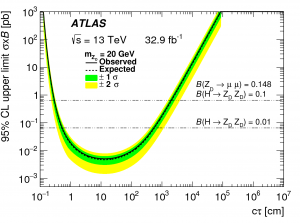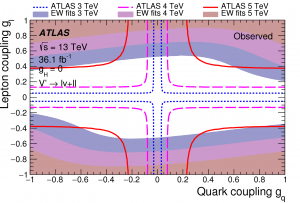Two new search articles with major involvement by UMass members have been submitted for publication this week. The searches utilize the data collected with the ATLAS detector in 2015 and 2016, corresponding to up to 36 inverse femtobarns of pp collisions.
The first article is a search for long-lived particles decaying into muons. The search is sensitive to variants of Supersymmetry known as Gauge-mediated models as well as to rare decays of the Higgs boson into dark sector particles referred to as “dark photons”. The new particles produced travel measurable distances inside the detector before decaying into muons.  Those muons are then reconstructed by the ATLAS muon spectrometer and found to be inconsistent with originating from the pp collision point. Limits are set and new particles are excluded over a wide range of lifetimes (see figure). The article has been submitted to Phys. Rev. D, see https://arxiv.org/abs/1808.03057.
Those muons are then reconstructed by the ATLAS muon spectrometer and found to be inconsistent with originating from the pp collision point. Limits are set and new particles are excluded over a wide range of lifetimes (see figure). The article has been submitted to Phys. Rev. D, see https://arxiv.org/abs/1808.03057.
The second article is the result of a combination of about a dozen searches for heavy resonances decaying into pairs of W, Z, or Higgs bosons, as well as pairs of leptons. By combining many searches in different decay channels, the sensitivity to physics beyond the Standard Model is significantly increased and the complementarity between those searches allows us to set stronger constraints on the couplings between the heavy resonances and fermions, Higgs bosons, and W/Z bosons.  The constraints from this combination are stronger than those extracted from precise electroweak measurements in nearly the full coupling parameter space (see figure). The article has been submitted to Phys. Rev. D, see https://arxiv.org/abs/1808.02380.
The constraints from this combination are stronger than those extracted from precise electroweak measurements in nearly the full coupling parameter space (see figure). The article has been submitted to Phys. Rev. D, see https://arxiv.org/abs/1808.02380.
For more information, see https://atlas.web.cern.ch/Atlas/GROUPS/PHYSICS/PAPERS/EXOT-2017-03/ and https://atlas.web.cern.ch/Atlas/GROUPS/PHYSICS/PAPERS/EXOT-2017-31/.